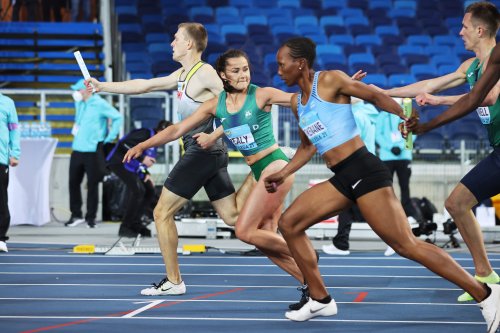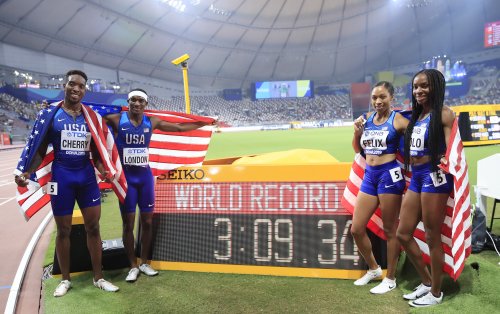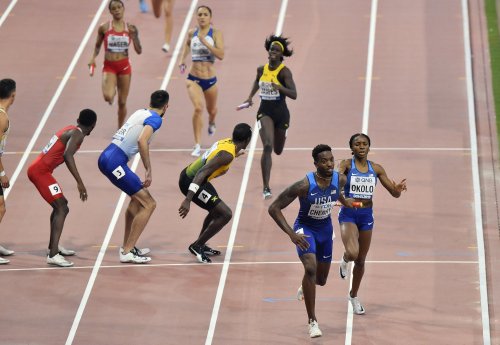 Mixed relay, photo by Krzysztof Wesołowski / World Athletics Relays Silesia 2021
Mixed relay, photo by Krzysztof Wesołowski / World Athletics Relays Silesia 2021
 Mixed relay, photo by Krzysztof Wesołowski / World Athletics Relays Silesia 2021
Mixed relay, photo by Krzysztof Wesołowski / World Athletics Relays Silesia 2021
In story 6, Stuart Weir opines on the mixed 4×400 relay. This is his last piece on Silesia 2021.
Deep thoughts on the mixed 4 X 400 relay.
The mixed 4 X 400 relay has been part of the program of the World Relays for a number of years. It came of age, so to speak, in 2019 when included in the World Championships in Doha. While the World Relays certainly includes serious competition, it is also a fun event. All the more so when the event hotel is a beach resort in the beautiful Bahamas! In Tokyo the mixed relay becomes an Olympic event.
Every athlete I have spoken to told me that they enjoyed running a mixed relay. You can still enjoy it, but when you are running for a World Championship medal, it becomes a bit more serious.
 Mixed relay, Doha WC 2019, photo by World Athletics
Mixed relay, Doha WC 2019, photo by World Athletics
One fascinating aspect of the event is that you are required to have two men and two women, but the running order is open. In Bahamas 2017, there were two different formats MFMF and MFFM with four finalists using each one. The fact that the two favourites Bahamas and USA used different formats added to the intrigue of the race.
Interestingly, at the 2021 World Relays, all eight teams decided to go with the MFFM format. In other events, I’ve seen teams go MMWW, building up a lead in the first half of the race and trying to hold it. Or alternatively, conceding an early lead, knowing that your two fastest runners are to come. For example at the 2019 World Championships in Doha, Poland had a woman [Justyna ÅšwiÄ™ty-Ersetic] on the last leg who started with a good lead but Michael Cherry (USA) was able to overtake her. In the 2021 World Relays mixed race, incidentally, men were on average six seconds faster than women over a lap.
Courtney Okolo, gold medallist in Doha told me: “It’s a lot of fun. I think the most fun in the championship was running the mixed. I think it’s best to do it boy/girl/boy/girl or girl/boy/girl/boy. I think that’s probably the way that works best”.
At the World Relays in 2017, Bahamas targeted the mixed, putting Shaunae Miller-Uibo and Steven Gardiner in the mixed rather than the single-sex relays. They won. Steven told me: “I enjoyed it. It was my first time that doing a mixed relay and I always wanted to do one. It was a little strange to hand the baton to a girl, not a guy, but was fun. Also I wasn’t expecting to have a female starting with me”.
Another Doha gold-medallist, Jess Beard’s comments express well the fun but competitive aspect: “Doha was my first mixed relay and I loved it. I was thinking I should have done this sooner. It was fun. I don’t know any other way to put it. Not that other relays aren’t fun but they are always very serious. Not that the mixed wasn’t serious but I didn’t know what the expectation was”. She added an interesting logistical point: “It was strange having a guy running towards me and I was wondering should I leave a little early because he’s faster?”
Tianna Bartoletta had an interesting perspective – describing mixed relays “like a NASCAR race. Because of the differences in the ways that men and women accelerate it could be a disaster”. Of a 4 by 100 mixed relay she said: “It would be fun to see but I don’t know if I would be brave enough to try it for myself”.
The attraction of the mixed relay is that a small nation like Bahamas which has currently, arguably the best male and female 400m runners but would not have 4 world-class men or women, can be competitive in a mixed relay.
The big issue that the mixed relay faces at championships is scheduling. Traditionally the individual 400 comes early in the program with three rounds and the relays with two rounds is at the end. In Doha 2019, the first championship with a mixed relay, the mixed was at the beginning of the program. That meant that few of the top 400 runners took part – not wanting two races in their legs before the gruelling three rounds of the individual. An exception was Salwa Eid Naser (Bahrain) who in Doha 2019 ran both rounds of the mixed relay before the three rounds of the individual 400 – which she won. Bahrain did not have a team in the women’s 4 by 400.
 Mixed relay, Doha WC 2019, photo by World Athletics
Mixed relay, Doha WC 2019, photo by World Athletics
USA on the other hand used 18 athletes in the two individual 400m races and the three relays in Doha 2019, so ensuring that no athlete needed to run too many races.
The argument that only needing two athletes of each gender gives smaller countries a better chance than relay races with 4 men or women, is strong. The evidence from Doha, however, suggests that big countries may have an advantage because their strength in depth allows them to use athletes in the mixed, who are not in the individual.
There is no perfect solution to the scheduling question.
.
Author

Since 2015, Stuart Weir has written for RunBlogRun. He attends about 20 events a year including all most global championships and Diamond Leagues. He enjoys finding the quirky and obscure story.
View all posts




















